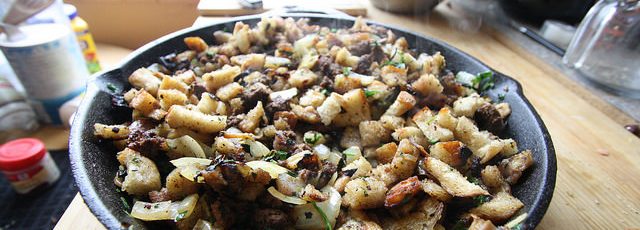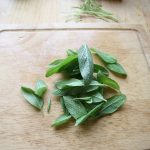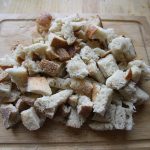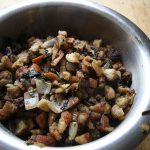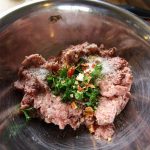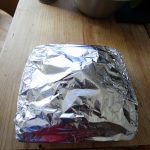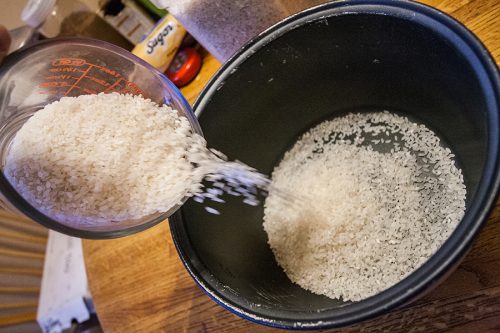So, what’s for dinner?
That’s always a problem, right? Pasta, or . . . What else is in the kitchen? Refrigerator? And the time factor? Do I need to go to the store?
In my house, there are a few things always on hand: vegetables, maybe some meat (leftover, marinated or unprepared), always uncooked rice (and often times, leftover sushi/vinegared rice, plain recipe).
For me, the easiest meal is often times the humble rice bowl. I cook up some rice in my rice cooker, I turn it into sushi/vinegared rice (blog post). Then, do I want to make sushi? Or a rice bowl? Or maybe onigiri? Or maybe, a few sushi rolls now and rice bowls for lunch tomorrow, and some onigiri (rice balls) for later? The options are endless.
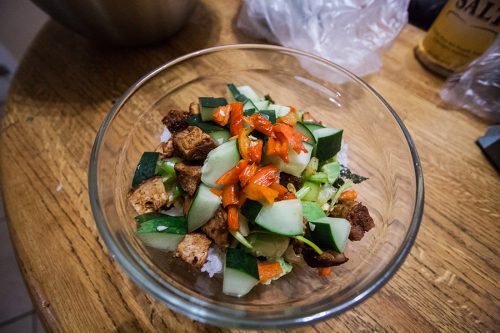
Peppers, grilled chicken, cucumbers and seaweed, at the very bottom, sit on top of rice in this rice bowl.
So, what is the rice bowl?
Well, it’s simple. You make some vinegared/sushi rice, put it in a bowl, cut up some veggies into bite-sized pieces, maybe cook up some meat and cut it up too, then throw it all on the rice.
Which veggies? Well, cucumbers are always nice, as are avocadoes. If you thinly slice, then deseed lemons, they are delicious. Being in New Mexico, I always add green chile peppers (unroasted) as well as jalepenos. Nori (seaweed) adds much needed taste. Green onions are also a good addition.
What else do you have? Throw it in there! Leftover steak? Cut it up, throw it in. Same goes for chicken, pork, or other meats.
Add some soy sauce, maybe some spicy/Sriracha mayonnaise, maybe some eel sauce, (Link to Amazon; once I make my own, I will post the recipe and update the link. Your local Asian store should have it for cheap.)
Bam! You’ve got a simple, relatively healthy dinner. Veggies, a little meat. Sure, the rice isn’t particularly healthy, but it’s frugal. Very, very frugal.

Avocados! Taste delicious in rice bowls, as do lemons. Seaweed is also a must.
(I buy sushi rice, Kokuho Rose variety, in 40 pound bags to be as frugal as possible. I store them in five-gallon buckets with lids, a carry over from my days as a homebrewer.)
There you go. Rice bowls. Simple. Delicious. Easy.
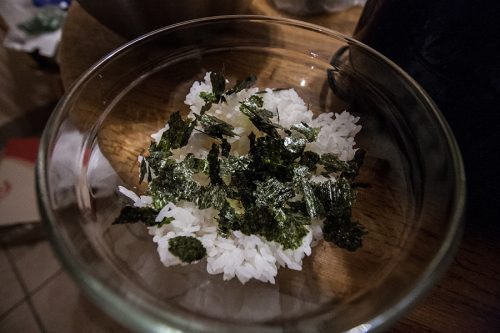
Seaweed (nori) is the first thing to go on top of the rice.
See all the photos on Flickr, in high quality.
Realized you don’t know how to make sushi rice? Here’s the recipe.
Want just the rice bowls recipe? Right here.
Simple rice bowls
Makes: as many as you have rice for
Ingredients
Sushi/vinegared rice
1/2 to 1/4 cucumber
1-3 green peppers
1 jalapeno (if you like it spicy)
1 piece of cooked meat (heated up if desired)
1/2 sheet of nori (seaweed sheets)
1 avocado
1 lemon, thinly sliced
All other vegetables, cooked or raw, as you see fit
Other ingredients as you see fit, or have seen in a sushi roll
Condiments such as eel sauce, Sriracha mayonnaise and eel sauce or cream cheese
Directions
1. Cut up the vegetables into bite-sized pieces. Cut the lemon slices into quarters.
2. Put enough rice into the bottom of a bowl.
3. Tear up the nori and place on top of the rice.
4. Put the cut up vegetables and meat, if using, on top of the nori, which is on top of the rice.
5. Heat up in the microwave for 30 second to 1 minute if working with leftovers or desire it hotter
6. Add condiments over the top and enjoy.

